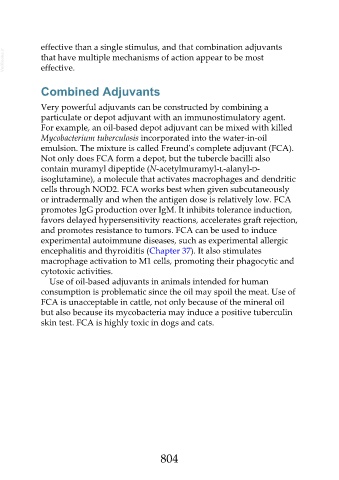Page 804 - Veterinary Immunology, 10th Edition
P. 804
effective than a single stimulus, and that combination adjuvants
VetBooks.ir that have multiple mechanisms of action appear to be most
effective.
Combined Adjuvants
Very powerful adjuvants can be constructed by combining a
particulate or depot adjuvant with an immunostimulatory agent.
For example, an oil-based depot adjuvant can be mixed with killed
Mycobacterium tuberculosis incorporated into the water-in-oil
emulsion. The mixture is called Freund's complete adjuvant (FCA).
Not only does FCA form a depot, but the tubercle bacilli also
contain muramyl dipeptide (N-acetylmuramyl-L-alanyl-D-
isoglutamine), a molecule that activates macrophages and dendritic
cells through NOD2. FCA works best when given subcutaneously
or intradermally and when the antigen dose is relatively low. FCA
promotes IgG production over IgM. It inhibits tolerance induction,
favors delayed hypersensitivity reactions, accelerates graft rejection,
and promotes resistance to tumors. FCA can be used to induce
experimental autoimmune diseases, such as experimental allergic
encephalitis and thyroiditis (Chapter 37). It also stimulates
macrophage activation to M1 cells, promoting their phagocytic and
cytotoxic activities.
Use of oil-based adjuvants in animals intended for human
consumption is problematic since the oil may spoil the meat. Use of
FCA is unacceptable in cattle, not only because of the mineral oil
but also because its mycobacteria may induce a positive tuberculin
skin test. FCA is highly toxic in dogs and cats.
804

